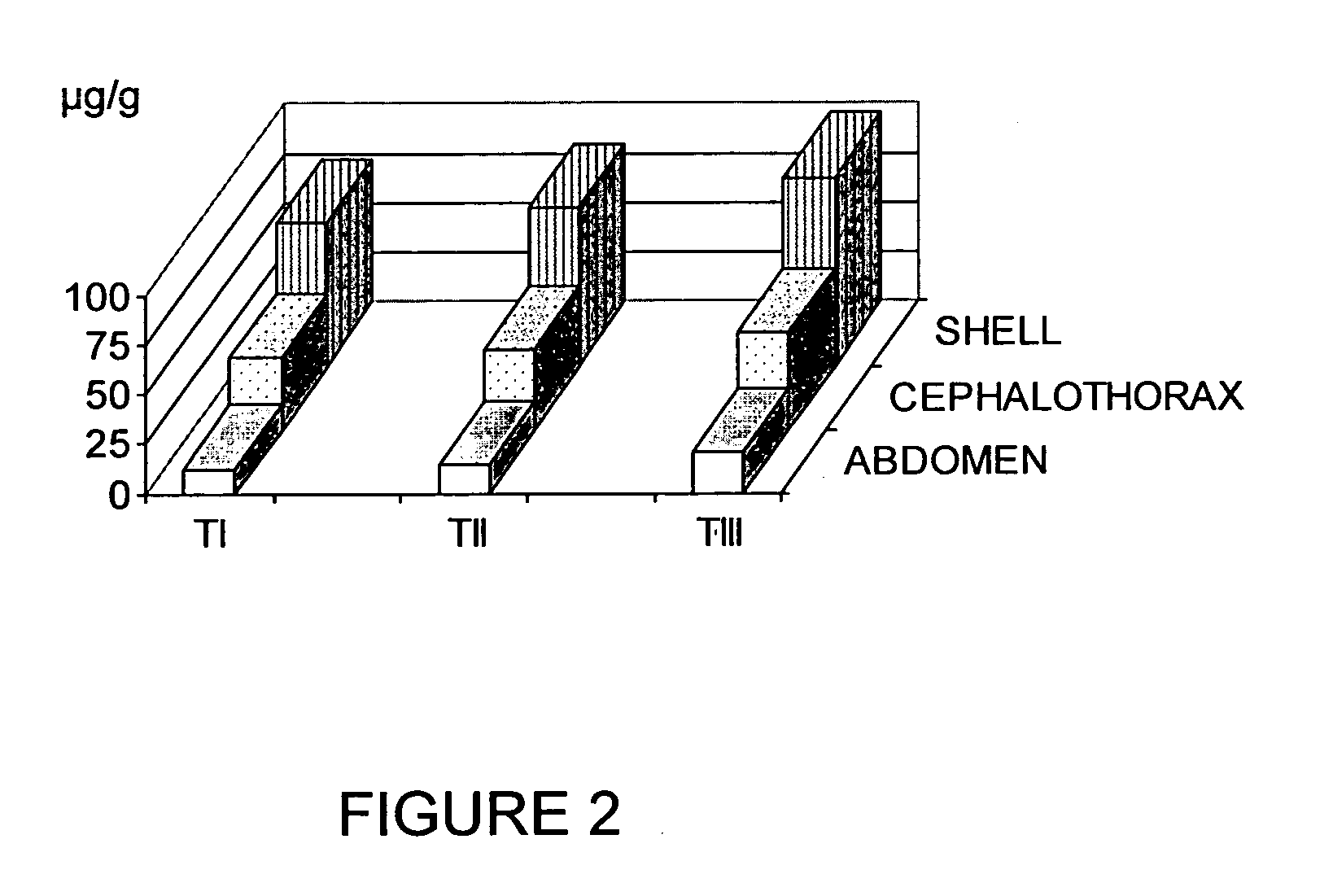Method for increasing the health condition of crustaceans in aquaculture
- Summary
- Abstract
- Description
- Claims
- Application Information
AI Technical Summary
Benefits of technology
Problems solved by technology
Method used
Image
Examples
example 1
[0043]1.—Dietary effect of the inclusion of Hi-Zea in the feed of a white shrimp Litopenaeus vannamei postlarvae (pl 7) cultivation.
[0044]An experiment was carried out with 6 treatments and three repetitions where white shrimp L. vannamei postlarvae (pl 7) were fed during 11 days with six different feed strategies. Treatments I to III included artemia nauplii. Besides artemia, Treatment TI was provided with commercial feed (40% protein). Treatment TII was supplemented with a commercial feed containing 138 ppm of xanthophylls, by including Hi-Zea in the formulation. Treatment TIII was provided with a microencapsulated commercial brand feed. Treatments IV to VI were provided with the same feed, but without artemia nauplii.
[0045]It can be observed in the graph of FIG. 1 that the Treatments including artemia nauplii (I to III), as well as those that did not include artemia (IV to VI), the experimental populations that were fed with Hi-Zea had a noticeable improvement in their survival (...
example 2
[0046]2.—Effect of dosing (Hi-Zea) in the feed of pre-juvenile (0.115 g) white shrimp Litopenaeus vannamei, grown under high density conditions.
[0047]An experiment was carried out comprising two treatments and three repetitions where pre-juvenile white shrimp L. vannamei were grown during 7 weeks, seeded at a high density (330 specimens / m2) in order to create a stress condition. In Treatment I a commercial feed was provided (40% protein). In Treatment II the commercial feed (40% protein) contained 138 ppm of xanthophylls from Hi-Zea.
[0048]As can be observed in Table I, the average weight as well as the average survival rate was significantly larger (ANOVA 0.05%) when Hi-Zea was used, as compared against those individuals that did not receive the carotenoid dose.
TABLE IFinal individual average weight and percentage of survival on Pre-juveniles of L. vannamei.Final average weight (g)Survival %Treatment I (Control)2.0266.6Treatment II (Hi-Zea)2.6373.1
example 3
[0049]3.—Dietary effect of dosing different concentrations of Hi-Zea in the feed of juvenile (2.5 g) white shrimp L. vannamei. Survival rate, growth, and pigmentation (astaxanthin deposition).
[0050]An experiment was carried out by triplicate, on an experimental stock of L. vannamei juveniles, being treated under different feeding strategies. On treatment I (Control) commercial feed with 35% protein was used, according to DICTUS formulation. On treatment II, Hi Zea was added to obtain a xanthophyll concentration of 58.7 ppm. On treatment III Hi Zea was added to obtain a xanthophyll concentration of 104.7 ppm.
[0051]After 30 days in the experimental ponds, the specimens were collected. Survival rate was determined to be significantly higher (ANOVA 0.05%) on experimental ponds treated with Hi Zea (Table II).
TABLE IIJuvenile survival of L. vannamei.TIII (105 ppm Hi-TITII (60 ppm Hi-Zea)Zea)Survival %889597
[0052]According to HPLC analysis, the Astaxanthin deposit on different body parts i...
PUM
 Login to View More
Login to View More Abstract
Description
Claims
Application Information
 Login to View More
Login to View More - R&D
- Intellectual Property
- Life Sciences
- Materials
- Tech Scout
- Unparalleled Data Quality
- Higher Quality Content
- 60% Fewer Hallucinations
Browse by: Latest US Patents, China's latest patents, Technical Efficacy Thesaurus, Application Domain, Technology Topic, Popular Technical Reports.
© 2025 PatSnap. All rights reserved.Legal|Privacy policy|Modern Slavery Act Transparency Statement|Sitemap|About US| Contact US: help@patsnap.com



